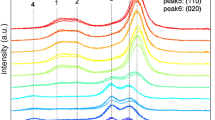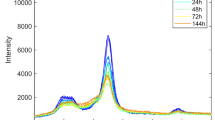Abstract
Terahertz (THz) radiation properties of cellulose nanocrystal (CNC) films, a CNC powder, and a dissolving pulp film are examined using THz time-domain spectroscopy. The relative permittivity (real component) of the CNC samples are found to vary between 1.78 and 3.81, over the frequency range of 0.2–1.5 THz, despite the fact that they are made from the same linear chain of glucose monomers. The results show that the permittivity is strongly dependent on the source from which the CNC glucose monomers are extracted, as well as on the drying process used. The THz loss tangent (0.043 < tan(δ) < 0.145), absorption coefficient (3.5 cm−1 < α < 63.7 cm−1), and growth-varying permittivity, combined with other appealing thermal and mechanical characteristic of CNC, make such material attractive for use in both passive and potential THz bandwidth electronic components.



Similar content being viewed by others
References
C. Zhou and Q. Wu, Recent development in applications of cellulose nanocrystals for advanced polymer-based nanocomposites by novel fabrication strategies, in Nanocrystals - Synthesis, Characterization and Applications; Ed. by S. Neralla (InTech, 2012), pp. 103–120.
B. L. Peng, N. Dhar, H. L. Liu and K. C. Tam, Chemistry and applications of nanocrystalline cellulose and its derivatives: a nanotechnology perspective, Can. J. Chem. Eng., 89, pp. 1191–1206 (2011).
I. Usov, G. Nyström, J. Adamcik, S. Handschin, C. Schütz, A. Fall, L. Bergström and R. Mezzenga, Understanding nanocellulose chirality and structure-properties relationship at the single fibril level, Nat. Commun., 6, pp. 7564 (2015).
R. Moon, S. Beck and A. Rudie, Cellulose nanocrystals – A material with unique properties and many potential applications, in Production and Applications of Cellulose Nanomaterials; Ed. by M. T. Postek, R. J. Moon, A. W. Rudie and M. A. Bilodeau (TAPPI PRESS, Peachtree Corners, GA, USA, 2013), pp. 9.
A. Dufresne, Nanocellulose: a new ageless bionanomaterial, Mater. Today, 16, pp. 220–227 (2013).
Y. Zhou, C. Fuentes-Hernandez, T. M. Khan, J. Liu, J. Hsu, J. W. Shim, A. Dindar, J. P. Youngblood, R. J. Moon and B. Kippelen, Recyclable organic solar cells on cellulose nanocrystal substrates, Sci. Rep., 3, pp. 1536 (2013).
S. Kalia, A. Dufresne, B. M. Cherian, B. S. Kaith, L. Avérous, J. Njuguna and E. Nassiopoulos, Cellulose-based bio- and nanocomposites: a review, Int. J. Polym. Sci., 2011, pp. 837875 (2011).
E. Lam, K. B. Male, J. H. Chong, A. C. Leung and J. H. Luong, Applications of functionalized and nanoparticle-modified nanocrystalline cellulose, Trends Biotechnol., 30, pp. 283–290 (2012).
L. Hu, G. Zheng, J. Yao, N. Liu, B. Weil, M. Eskilsson, E. Karabulut, Z. Ruan, S. Fan, J. T. Bloking, M. D. McGehee, L. Wågberg and Y. Cui, Transparent and conductive paper from nanocellulose fibers, Energy Environ. Sci., 6, pp. 513–518 (2013).
H. Zhu, Z. Xiao, D. Liu, Y. Li, N. J. Weadock, Z. Fang, J. Huang and L. Hu, Biodegradable transparent substrates for flexible organic-light-emitting diodes, Energy Environ. Sci., 6, pp. 2105–2111 (2013).
J. Huang, H. Zhu, Y. Chen, C. Preston, K. Rohrbach, J. Cumings and L. Hu, Highly transparent and flexible nanopaper transistors, ACS Nano, 7, pp. 2106–2113 (2013).
D. Gaspar, S. N. Fernandes, A. G. de Oliveira, J. G. Fernandes, P. Grey, R. V. Pontes, L. Pereira, R. Martins, M. H. Godinho and E. Fortunato, Nanocrystalline cellulose applied simultaneously as the gate dielectric and the substrate in flexible field effect transistors, Nanotechnology, 25, pp. 094008 (2014).
T. Kleine-Ostmann, K. Pierz, G. Hein, P. Dawson, M. Marso and M. Koch, Spatially resolved measurements of depletion properties of large gate two-dimensional electron gas semiconductor terahertz modulators, J. Appl. Phys., 105, pp. 093707 (2009).
N. Pala, D. Veksler, A. Muravjov, W. Stillman, R. Gaska and M. S. Shur, Resonant detection and modulation of terahertz radiation by 2DEG plasmons in GaN grating-gate structures, in IEEE Sensors 2007 Conference, Atlanta, GA, USA, pp. 570–572 (2007).
E. Fortunato, N. Correia, P. Barquinha, L. Pereira, G. Gonçalves and R. Martins, High-performance flexible hybrid field-effect transistors based on cellulose fiber paper, IEEE Electr. Device L., 29, pp. 988–990 (2008).
R. Martins, P. Barquinha, L. Pereira, N. Correia, G. Gonçalves, I. Ferreira and E. Fortunato, Write-erase and read paper memory transistor, Appl. Phys. Lett., 93, pp. 203501 (2008).
R. Martins, A. Nathan, R. Barros, L. Pereira, P. Barquinha, N. Correia, R. Costa, A. Ahnood, I. Ferreira and E. Fortunato, Complementary metal oxide semiconductor technology with and on paper, Adv. Mater., 23, pp. 4491–4496 (2011).
R. F. P. Martins, A. Ahnood, N. Correia, L. M. N. P. Pereira, R. Barros, P. M. C. B. Barquinha, R. Costa, I. M. M. Ferreira, A. Nathan and E. E. M. C. Fortunato, Recyclable, Flexible, Low-Power Oxide Electronics, Adv. Funct. Materials, 23, pp. 2153–2161 (2013).
R. Martins, I. Ferreira and E. Fortunato, Electronics with and on paper, Phys. Status Solidi-R, 5, pp. 332–335 (2011).
R. Martins, B. Brás, I. Ferreira, L. Pereira, P. Barquinha, N. Correia, R. Costa, T. Busani, A. Gonçalves, A. Pimentel and E. Fortunato, Away from silicon era: the paper electronics, Proc. SPIE, 7940, pp. 79400P (2011).
Y. Peng, D. J. Gardner and Y. Han, Drying cellulose nanofibrils: in search of a suitable method, Cellulose, 19, pp. 91–102 (2012).
T. C. Choy, The concentric shell model, in Effective Medium Theory: Principles and Applications (Oxford University Press, Clarendon, Oxford, UK, 1999), pp. 31.
H. Guo, M. He, R. Huang, W. Qi, W. Guo, R. Su and Z. He, Changes in the supramolecular structures of cellulose after hydrolysis studied by terahertz spectroscopy and other methods, RSC Adv., 4, pp. 57945–57952 (2014).
Acknowledgments
This research was funded by the Natural Sciences and Engineering Research Council of Canada (NSERC).
Author information
Authors and Affiliations
Corresponding author
Appendix A CNC Preparation Technique
Appendix A CNC Preparation Technique
A CNC-water solution is obtained through an acid hydrolysis reaction of cellulosic pulp, which occurs in a Pfaudler 50-gal glass-lined reactor. Typically, 140 kg of 64 wt% sulfuric acid is pumped into the reactor from an acid storage tank. The acid is then stirred (or mixed) and heated up to 45 °C through the reactor jacket with low-pressure steam. Once at temperature, 10 to 14 kg of feedstock pulp (untreated or pre-treated) is added into the reactor. After reacting for 2 h, 50 kg of distilled water is pumped into the reactor to quench the reaction and then the hydrolysate mixture is transferred to a 7800 L tank containing approximately 1200 kg reverse osmosis (RO) water.
The CNC hydrolysate is neutralized by slowly adding 30 wt% NaOH to approximately pH 7. The neutralized CNC suspension is clarified or centrifuged at 6500 rpm using a GEA Westfalia SC-35 disk stack centrifuge to separate the CNC product from the waste stream containing glucose, sugar oligomers, sodium sulfate salt, and other water-soluble contaminates. The centrate is sent to sewage and the solids discharge is pumped to a storage tank and diluted with 1500 L water. At this stage, the CNC particles begin to suspend or disperse in the water. Next, the aqueous suspension is transferred to the tangential flow filtration system for the first stage of purification. The CNC suspension is circulated through a parallel series of hollow fiber tube modules with a molecular weight cutoff of 50,000 Da, where the dilute, low molecular weight salt/sugar contaminates pass through the membrane, while CNC particles are retained within the tubes. RO water is added as required to maintain the CNC concentration at 0.5 %. This diafiltration is continued until the conductivity of the suspension is reduced to <20 μS/cm. The purified CNC suspension is then centrifuged to remove large particles and unreacted materials. At this stage, the CNC particles are retained in the centrate and the colloidal CNC suspension is filtered using a 10 μm cartridge-style filter to remove small unreacted cellulosic materials. The resulting clean CNC suspension is transferred to an ultrafiltration system (GEA-Niro) for the second stage of purification until the conductivity of the suspension is reduced to <100 μS/cm. This purification technique utilizes the same filtration system used for diafiltration. The purified CNC suspension is concentrated up to 3 % using the ultrafiltration system and pumped to a 300 L transfer vessel.
Rights and permissions
About this article
Cite this article
Carnio, B.N., Ahvazi, B. & Elezzabi, A.Y. Terahertz Properties of Cellulose Nanocrystals and Films. J Infrared Milli Terahz Waves 37, 281–288 (2016). https://doi.org/10.1007/s10762-015-0225-x
Received:
Accepted:
Published:
Issue Date:
DOI: https://doi.org/10.1007/s10762-015-0225-x




